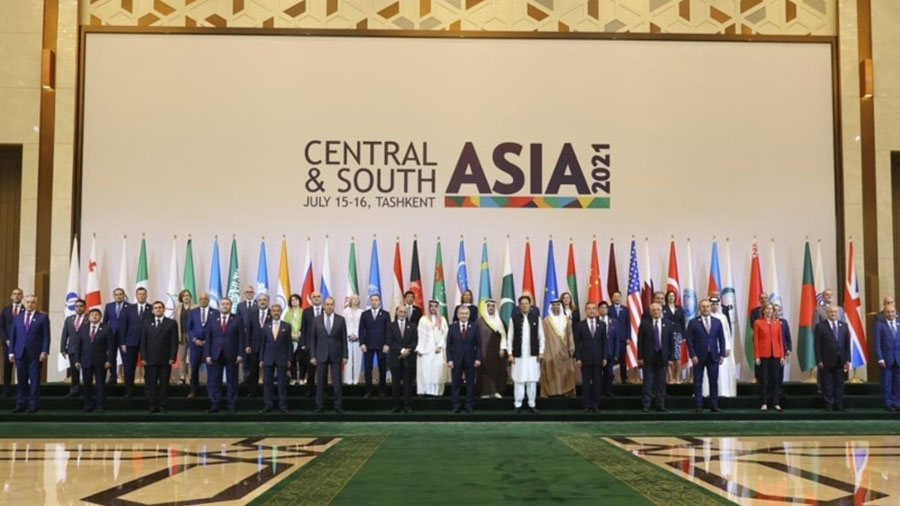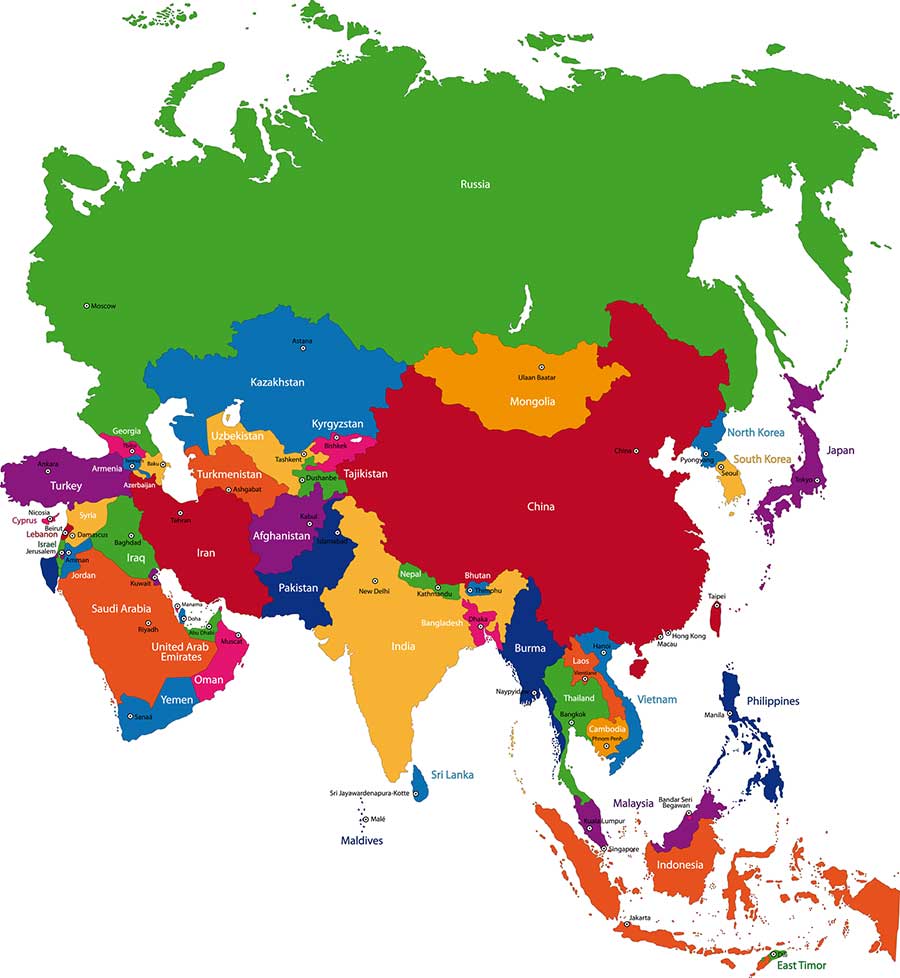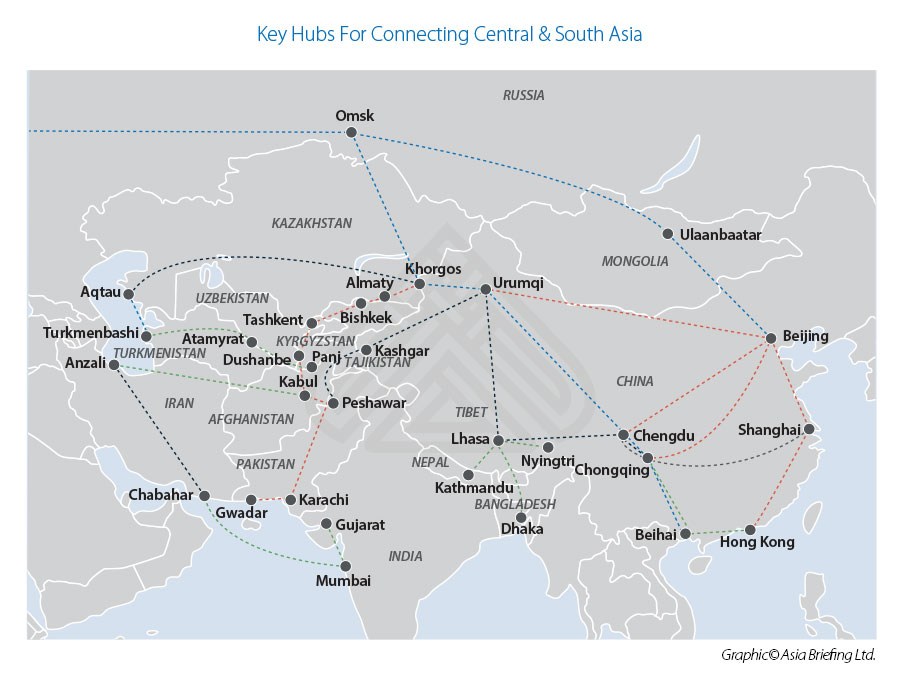China Urges Interconnection Between Central And South Asian Countries

By Chris Devonshire-Ellis
Four-point regional plan unveiled to unite Eurasia
China is ready to “join hands with Central and South Asian countries to forge a closer regional connectivity partnership through high-quality cooperation under the Belt and Road Initiative” Chinese State Councilor and Foreign Minister Wang Yi remarked in Tashkent last Friday.
Wang was speaking at the ‘Central and South Asia: Regional Connectivity, Challenges, and Opportunities’ inter-governmental conference hosted by Uzbekistan. The Prime Ministers and Foreign Ministers of Afghanistan and Pakistan, foreign ministers of countries including China, Russia, Kazakhstan, Tajikistan, Turkmenistan, India, Bangladesh, the Maldives, Saudi Arabia, Kuwait and Turkey, the United Nations secretary-general, and the European Union high representative for foreign affairs and security policy attended the conference.
“Connectivity has been an unremitting pursuit of human society since ancient times and plays as a key impetus to development and prosperity in today’s world. The Chinese people and the peoples of Central and South Asia have been living in adjacent to each other with a long history of friendly exchanges” Wang said.

Since Chinese President Xi Jinping introduced the joint building of the BRI in 2013, bilateral relations and cooperation between China and Central and South Asian countries have become all the closer, he noted.
Wang made a four-point proposal on promoting connectivity in Central and South Asia.
- Countries in the region should stick to openness and inclusiveness and uphold the spirit of partnership, and that only by staying open can they create powerful synergy for connectivity.
- China opposes playing geopolitical games in the name of connectivity and is willing to follow the principles of extensive consultation, joint contribution, and shared benefits, to create a bright future of integrated development with all parties.
- All countries pursue both hardware and software development in promoting infrastructure connectivity.
- China is ready to work with all parties to align their infrastructure development strategies, push forward ‘hard connectivity’ and ‘soft connectivity’ in parallel, and build an all-dimensional, multifaceted and sustainable connectivity network.
Wang stated that China supports the building of a corridor connecting Central and South Asia, helping countries in the region transform from ‘landlocked’ to ‘land-connected’ nations, and jointly building a major international transport route connecting Europe with Asia and linking the north with the south. This has particular relevance for countries such as Kyrgyzstan, Tajikistan and Uzbekistan, and is vital in the future for Afghanistan. All are landlocked yet can utilize Afghanistan’s unique position at the heart of Central Asia to access seaports in Pakistan and Iran, and through routes running West and into markets of the Eurasian Economic Union from the Caspian Sea.
Wang called on the World Bank, the Asian Infrastructure Investment Bank, the Asian Development Bank, and the Silk Road Fund to invest in connectivity projects, broaden diverse financing channels, and widely attract investment from private and social sectors so that these projects will receive stable, transparent, and high-quality financial support. In addition, Wang said the countries should stick to the principle of common security and overcome obstacles in the cooperation.
China urges relevant countries to honor their commitments, fulfill their obligations, and strive to prevent the deterioration of the security situation in Afghanistan, he said. China will continue to work with the international community, especially Afghanistan’s neighboring countries, to facilitate peace talks and give full play to the role of the Shanghai Cooperation Organization and other mechanisms, Wang said.
He added that China will deepen law enforcement and security cooperation with all parties, jointly combat the ‘three evil forces’ of terrorism, extremism and separatism, drug trafficking and transnational organized crimes, and strengthen the security measures for cooperation projects under the BRI, to create a stable, secure and peaceful external environment for the construction of regional interconnectivity.
Central Asia in Numbers
| Country | Population (millions) | GDP (PPP) (billions) |
|---|---|---|
| Afghanistan | 38 | 20 |
| Iran | 39 | 454 |
| Kazakhstan | 19 | 182 |
| Kyrgyzstan | 6.5 | 8.5 |
| Pakistan | 217 | 278 |
| Tajikistan | 9.5 | 8.2 |
| Turkmenistan | 6 | 41 |
| Uzbekistan | 34 | 58 |
| Siberia Federal District | 34 | 440 |
| Xinjiang Province | 25 | 213 |
| Total: | 428 | 1702 |
If taken as a total population, this Central Asian region as depicted above would be the world’s third most populous after China and India, with a GDP roughly equivalent to that of Canada. That disparity between population and wealth means there is huge potential for growth – if infrastructure can be put in place. Russia for example would benefit hugely by having Siberia better connected with Central Asia – and especially if that led to routes elsewhere.

Connecting Siberia to Asia
Omsk is an important rail hub and connects north and south Siberia with the Trans-Siberian routes heading to Europe as well as into Mongolia, Kazakhstan, and south to China.
Connecting Russia to Vietnam via Gansu, Qinghai, and Yunnan
Asia’s highest altitude railway tunnel was quietly completed last month, as part of the Dongshan Tunnel complex in Northwest China’s Qilian Mountains. It is expected to significantly increase traffic flow between Gansu and Qinghai, cutting more than 400 kilometers on the previous road connections and about five hours in time. To the north, this route connects through Kazakhstan and to Omsk in Siberia, to the south, with Yunnan Province to the border with Vietnam. It’s not as far-fetched as it sounds – Vietnam already has a Free Trade Agreement with the Eurasian Economic Union.
Connecting Xinjiang to the South China Sea
Hi-speed rail already connects Xinjiang to Beijing and Shanghai, routes heading south will connect with Chongqing and Chengdu and onto Beihai in China’s Guangxi Province and from there, through to the south-east ASEAN markets of Vietnam, Indonesia and so on. It is known as the Western Land-Maritime Corridor The Guangxi Ports will also open up China’s hinterland of some 280 million people, equivalent to seven California’s, of which about 100 million are to middle class consumer standards, yet to date have been difficult to access. It gives Xinjiang Province Sea port access for the first time.
Reconnecting Lhasa’s Sea Port Access
Old trade routes used to run between Tibet’s capital Lhasa and Calcutta and out into the Bay of Bengal and access to the Indian Ocean and South China Sea. While that is unlikely to reconnect anytime soon, China has planned rail extensions from Lhasa to Nyingtri close to Tibet’s border with India. Should there be future rapprochement between China and India, that route could connect through to the main Indian rail network. An alternative is to connect Lhasa with Dhaka Port in Bangladesh, with nearby access to Ports in Myanmar. Feasibility studies are being conducted.
Connecting Uzbekistan to the Arabian Gulf
Land-locked Uzbekistan is a rising economic star in Central Asia and has set itself on a path of reforms and compliance with international standards. It has recently signed off an agreement with Afghanistan and Pakistan to develop the Trans-Afghan Railway which would connect the capital, Tashkent, with Pakistani Ports at Gwadar and Karachi. The World Bank has agreed most of the funding. Uzbekistan is already connected by rail to Kazakhstan and Tajikistan, providing these economies also with seaport access.
Connecting China Directly to the Middle East: Kyrgyzstan’s Railway
A long-held dream along the Silk Road both old and new has been a railway that links China to Central Asia and the Middle East. Getting it done however is proving difficult: Kyrgyzstan lies in the middle. Anyone that has visited the Chinese city of Kashgar and even beyond to Taxkorgan will understand the difficulties of travelling across the Pamir Mountain ranges; huge, jagged peaks prone to shale and slate landslides in a geologically unstable region. A multimodal route already exists, using lorries to traverse Kyrgyzstan. But the real solution lies in building rail connecting West China through Kyrgyzstan and onto Uzbekistan and beyond. Currently, that route is served by rail passing through Kazakhstan’s Khorgos, but estimates show that the Kyrgyz route would save five days from the transshipment time. That prospect might not be great news for Kazakhstan, but several other countries stand to benefit from such a route if a route can traverse Kyrgyzstan. Proposed extensions would run through Afghanistan, Iran, and Turkey to Europe, while another would run through Turkmenistan and, by ferry, across the Caspian Sea to Istanbul and to Europe.
Financing the route is the issue. There are ways that China can assist. It benefits longer term as its trade through Central Asia and onto the Middle East will increase. It will win via security as well; settling down Uyghur unrest via creating wealth through trade is an on-going process. It also provides China with a third corridor West and keeps both Kazakhstan and Russia competitive. Low-interest loans are a given along BRI projects, and China can either waive or partially waive these by taking a mortgage against Kyrgyzstan’s future transit fees. Kyrgyzstan needs the increased interconnectivity a completed railway will bring, both in terms of the transit fees it can earn, and in increased trade viability of its own products. Discussions are on-going.
The International North-South Transportation Corridor: Connecting India to Russia
The International North-South Transportation Corridor (INSTC) completes the Western section of the overall Central Asian connectivity and is designed to allow India access to regional markets – and Russia – while avoiding transport across Pakistan, with whom diplomatic and trade issues remain problematic. Its regional importance has recently been showcased as an alternative to the Suez Canal and its recent blockage.
Russia, Iran, and India have been working on the creation of this 7,200 km, multimodal trade corridor for nearly two decades, with work on the project recently accelerating amid growing trade between countries in the region, and between India and Europe. Use of the INSTC as an alternative to the Suez reduces travel times to 20 days and savings of up to 30 percent. With a spur planned to cross the Iran-Afghan border and head east to Kabul, the INSTC completes a circular route that if completed, would extend around Central Asia, offering interfaces with Russia, China, the Middle East, East Africa, to South and East Asia.
Pending Free Trade Agreements
China signed off an FTA with the Eurasian Economic Union (EAEU) in 2018. Including Armenia, Belarus, Kazakhstan, Kyrgyzstan and Russia, the FTA is non-preferential, however tariff reduction negotiations are underway. Uzbekistan is currently an observer pending membership, while Mongolia, India and Pakistan are negotiating terms. Iran has an FTA with the EAEU as do Singapore and Vietnam. Several other ASEAN members are also looking at similar trade agreements.
Clearly, although building the connecting Central-South Asian connecting infrastructure will take time, much will be in place by the end of the decade. Once completed, the next stage in the Greater Eurasian Partnership will be drawing in the Middle East, Turkey, which is already connected via the Baku-Tbilisi-Kars (BTK) rail links and structuring trade agreements with the European Union. Brussels will see where the new trade opportunities are in these emerging markets and will be keen to sell its higher value products. That interest is already happening – the EU has granted Uzbekistan GSP+ trading privileges, going beyond standard GSP, alongside commitments to sustainable development under the arrangement. The GSP+ arrangements came into effect on 10th April; reflecting the EU’s plans to further develop ties with Central Asian economies.
Add FTA into the mix and the trade routes that once criss-crossed the Asian region in the ancient Silk Road times are highly likely to be re-energized and provide significant boosts and opportunities in intra-Asian trade, and European trade.
Related Reading
About Us
Silk Road Briefing is written by Dezan Shira & Associates. The firm has 28 offices throughout Asia, and assists foreign investors into the region. For strategic advisory and business intelligence issues please contact the firm at silkroad@dezshira.com or visit www.dezshira.com





